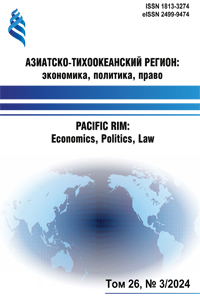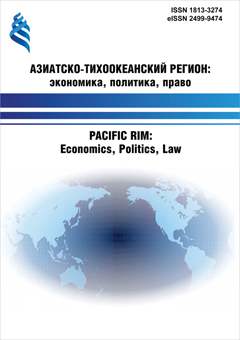Trans-Pacific partnership and regional comprehensive economic partnership as a model international legal structure for economic integration in the Asia-Pacific
DOI:
https://doi.org/10.24866/1813-3274/2024-3/55-72Keywords:
Asia-Pacific region, trade and economic integration, international law, regional trade agreement, regional economic integration organization, free trade area, TransPacific Partnership, Regional Comprehensive Economic Partnership, World Trade OrganizationAbstract
The article explores international law aspects of the contemporary integration processes in the Asia-Pacific with a specific focus on such relatively new formations
as the Trans-Pacific Partnership (TPP) and the Regional Comprehensive Economic Partnership (RCEP). Based on the WTO law provisions with regard to the free trade areas for goods and services, both Partnerships significantly widen the scope of regulated inter-governmental relationships, which allows considering the TPP and the RCEP as a fundamentally new form of the regional trade agreements. Having a fixed number of participating states and a system of institution with their functions and competencies, the Partnerships do not represent inter-governmental organizations and are vested with no legal capacity or, especially, supranational powers. However, this does not undermine the trade and economic significance of the Partnerships while also making them an attractive model of the soft integration structure between the states having different level of economic development, located in different geographical regions and bound with their own integration obligations under bi- and multilateral (subregional) trade agreements. The founding agreements of the Partnerships are typical “WTO plus” arrangements combining the provisions on liberalization of trade in goods and services with the parties’ mutual obligations in the fields of investments, sustainable development, competition, administrative and legal cooperation. At the same time, applicability of parallel bi- and multilateral trade agreements between the Asia-Pacific states, including those within ASEAN, forms a complex multilayer regulation of foreign trade and entails a risk of legal uncertainty for economic operators.
Downloads
References
Глобализация и интеграционные процессы в Азиатско-Тихоокеанском регионе (правовое и экономическое исследование): монография / Н.М. Бевеликова, Н.Г. Доронина, О.О. Журавлева [и др.]; под ред. Т.Я. Хабриевой. М.: ИЗиСП, ИНФРА-М, 2014. 333 с.
Asia-Pacific Trade Agreement: an evolving preferential regional trade agreement. URL: https://www.unescap.org/kp/2022/asia-pacific-trade-agreement-evolving-preferential-regional-trade-agreement.
Цзюньтао В., Любина Д.Е. Транс-тихоокеанское партнерство: история поэтапного развития региональной интеграции в АТР // Проблемы постсоветского пространства. 2021. Т. 8, № 1. С. 113–122. https://doi.org/10.24975/2313-8920-2021-8-1-113-122.
Костюнина Г.М., Баронов В.И. Транстихоокеанское партнерство: основные положения соглашения и потенциальный эффект // Международная жизнь. 2016. № 2. С. 90–112.
Перская В.В., Эскиндаров М.Л. Точки сопряжения экономических стратегий развития государств – членов АТЭС и ШОС – при переходе к многополярности (методологические подходы и инструментарий выявления сфер взаимного интереса). М.: Экономика, 2013. 388 с.
Вельяминов Г.М. Международное право: опыты. М.: Статут, 2015. 1006 с.
Доронина Н.Г., Казанцев Н.М., Семилютина Н.Г. Правовое регулирование экономических отношений: глобальное, национальное, региональное: монография. М.: ИЗиСП, НОРМА, ИНФРА-М, 2017. 160 с.
Красинский В.В. Защита государственного суверенитета: монография. М.: НОРМА, ИНФРА-М, 2017. 608 с.
Словарь международного права / Т.Г. Авдеева, В.В. Алешин, Б.М. Ашавский [и др.]; отв. ред. С.А. Егоров. 3-е изд., перераб. и доп. М.: Статут, 2014. 495 с.
Скурко Е.В. Глобальная и региональная торгово-экономическая интеграция. Эффективность правового регулирования. СПб.: Юрид. центр Пресс, 2004. 297 с.
Международное право: учебник / Б.М. Ашавский, М.М. Бирюков, В.Д. Бордунов и др.; отв. ред. С.А. Егоров. 5-е изд., перераб. и доп. М.: Статут, 2014. 1087 с.
Мисько О.Н. Международная экономическая интеграция. СПб.: Университет ИТМО, 2015. 174 с.
Каширкина А.А., Морозов А.Н. Международно-правовые модели Европейского союза и Таможенного союза: сравнительный анализ: монография. М.: ИЗиСП, 2012. 368 с.
Рафалюк Е.Е., Залоило М.В., Власова Н.В. Понятия, виды и формы евразийского и латиноамериканского интеграционных объединений (сравнительно-правовой анализ) // Журнал российского права. 2016. № 1. С. 154–168.
Костюнина Г.М. Особенности интеграционных процессов в Азиатско-Тихоокеанском регионе / Г.М.Костюнина // Россия: тенденции и перспективы развития. Ежегодник. Вып. 12 / РАН. ИНИОН. Отд.науч. сотрудничества; отв. ред. В.И. Герасимов. М., 2017. Ч. 1. С. 300–305.
Downloads
Published
Issue
Section
License
Copyright (c) 2024 Антон Аркадьевич Наку

This work is licensed under a Creative Commons Attribution-NonCommercial-NoDerivatives 4.0 International License.



